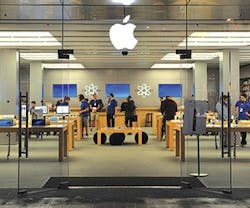What is it we do when we shop? We all know that “buying stuff” is at the heart of it, as the cynics always keenly point out during the holidays. But there are those of us—and ladies, feel free to back me up on this—for whom it’s much more than that. As designers and consumers, we know better than almost anyone how sophisticated the shopping experience has become.
The retail space is much more than a store where goods are available for purchase. It’s a thoroughly planned series of sensations designed to entice consumers and make them want to be part of the brand narrative and experience. And it’s the enjoyment and escape we find in these narratives that make the shopping experience so wholly therapeutic.
Strolling down Rodeo Drive recently, I found myself fascinated by the integration of brand and product. All of the brands found there are about luxury and their interiors respond in kind. Products are displayed like pieces of art in a gallery, while the lush materiality and detail of their environments reflect the style trends of the products they house—all while staying true to the brands they represent. It’s this seamless integration that creates continuity, visual excitement and the urge to immerse one’s self in a space.
That’s our skill as designers at work. The most successful retail designs get the consumer to experience the product by experiencing the space; shopping for the product and experiencing the environment become one activity. In some cases, like the Apple Store, the company logo is almost secondary. The consumer can know, appreciate and understand the brand based on the space alone. It’s a representation of the product and its brand: clean, accessible and innovative.
Likewise, Apple’s products are user-friendly, accessible and impeccably designed with minimal brilliance. The innovation is there, embodied in a simple item, product or housing. This also holds true for the brand’s store design. The complexity of that glass-curtain wall or those floating glass stairs is significant, but what the consumer experiences is elegant simplicity. Yes, there is an Apple logo, but I would suggest that even if there were not, the consumer would recognize the brand—and, more importantly, understand the goals and qualities of the product.
Another broadly known retailer, Anthropologie, successfully integrates its spaces with its brand, but does so in an entirely different way. The company sends people around the world in search of distinctive fixtures that complement the brand’s “global” aesthetic. The result is a surprisingly and seamlessly integrated brand identity that emphasizes the unexpected—every outlet’s design is unique, yet functions with absolute consistency due to the overall design approach.
Rather than filling the space with its merchandise, Anthropologie maintains a wide open floor that instills in customers a bit of the wanderlust that informs the brand. Product displays are inventive, visually appealing and direct not just the eye but the consumer around the store, encouraging him or her to discover what might be elsewhere in the space. Simply put, Anthropologie’s store design offers consumers something of a synoptic travel experience, replete with discovery and a sense of escape.
This fusion of brand, product, space and experience should be a primary concern to any designer working in the retail sector today. With the advent of online shopping, the physical retail experience has become more and more critical. We no longer have to go to a shop to buy something—the virtual world has made buying very easy and convenient for us. It’s the experience of a space and the products within it that draw us to the tactile, stimulating act of shopping.
Even as concepts familiar to us migrate to branded retail websites, as retail giants strive to deliver the same in-store experience in a digital fashion, those of us who know the power of design—and how to wield it—are in the best position to differentiate the two. We grasp the importance of a strong physical retail presence for our clients, of course, but we also understand the potency and impact of a well-integrated space on the consumer.
The most successful branded retail environments involve the consumer in a psychological and emotional journey, a narrative that they can only truly become part of by walking in the front door. If we as designers can offer that continuity of experience that invites people to step inside and take part in our clients’ brand narratives, we’ll have done more than our jobs—we’ll have delivered a transcendent, contemporary experience that enriches the community at large and offers a respite for the world-weary consumer who simply needs to get away.
IIDA President Felice L. Silverman, IIDA is president and a principal at Silverman Trykowski Associates Inc. in Boston. You can reach IIDA at (312) 467-1950 or at [email protected].
